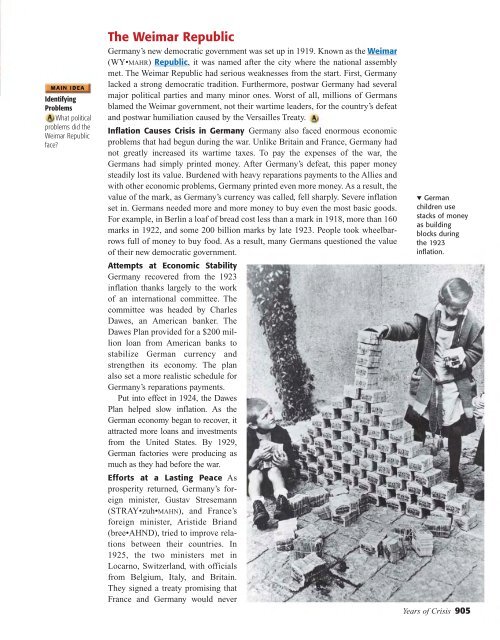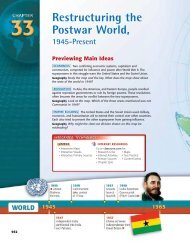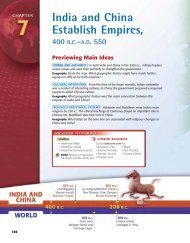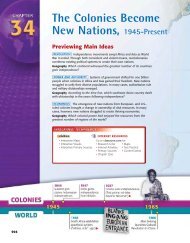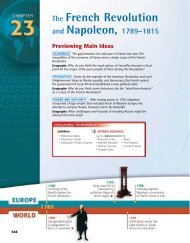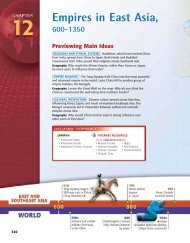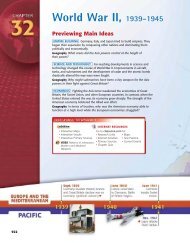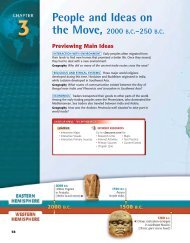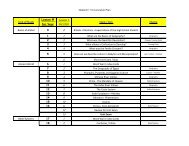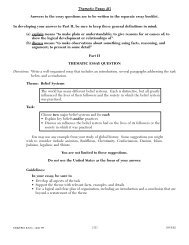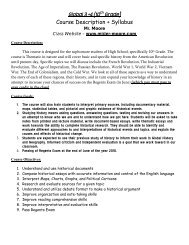Years of Crisis, 1919–1939 - Mister Moore
Years of Crisis, 1919–1939 - Mister Moore
Years of Crisis, 1919–1939 - Mister Moore
Create successful ePaper yourself
Turn your PDF publications into a flip-book with our unique Google optimized e-Paper software.
Identifying<br />
Problems<br />
What political<br />
problems did the<br />
Weimar Republic<br />
face?<br />
The Weimar Republic<br />
Germany’s new democratic government was set up in 1919. Known as the Weimar<br />
(WY•MAHR) Republic, it was named after the city where the national assembly<br />
met. The Weimar Republic had serious weaknesses from the start. First, Germany<br />
lacked a strong democratic tradition. Furthermore, postwar Germany had several<br />
major political parties and many minor ones. Worst <strong>of</strong> all, millions <strong>of</strong> Germans<br />
blamed the Weimar government, not their wartime leaders, for the country’s defeat<br />
and postwar humiliation caused by the Versailles Treaty.<br />
Inflation Causes <strong>Crisis</strong> in Germany Germany also faced enormous economic<br />
problems that had begun during the war. Unlike Britain and France, Germany had<br />
not greatly increased its wartime taxes. To pay the expenses <strong>of</strong> the war, the<br />
Germans had simply printed money. After Germany’s defeat, this paper money<br />
steadily lost its value. Burdened with heavy reparations payments to the Allies and<br />
with other economic problems, Germany printed even more money. As a result, the<br />
value <strong>of</strong> the mark, as Germany’s currency was called, fell sharply. Severe inflation<br />
set in. Germans needed more and more money to buy even the most basic goods.<br />
For example, in Berlin a loaf <strong>of</strong> bread cost less than a mark in 1918, more than 160<br />
marks in 1922, and some 200 billion marks by late 1923. People took wheelbarrows<br />
full <strong>of</strong> money to buy food. As a result, many Germans questioned the value<br />
<strong>of</strong> their new democratic government.<br />
Attempts at Economic Stability<br />
Germany recovered from the 1923<br />
inflation thanks largely to the work<br />
<strong>of</strong> an international committee. The<br />
committee was headed by Charles<br />
Dawes, an American banker. The<br />
Dawes Plan provided for a $200 million<br />
loan from American banks to<br />
stabilize German currency and<br />
strengthen its economy. The plan<br />
also set a more realistic schedule for<br />
Germany’s reparations payments.<br />
Put into effect in 1924, the Dawes<br />
Plan helped slow inflation. As the<br />
German economy began to recover, it<br />
attracted more loans and investments<br />
from the United States. By 1929,<br />
German factories were producing as<br />
much as they had before the war.<br />
Efforts at a Lasting Peace As<br />
prosperity returned, Germany’s foreign<br />
minister, Gustav Stresemann<br />
(STRAY•zuh•MAHN), and France’s<br />
foreign minister, Aristide Briand<br />
(bree•AHND), tried to improve relations<br />
between their countries. In<br />
1925, the two ministers met in<br />
Locarno, Switzerland, with <strong>of</strong>ficials<br />
from Belgium, Italy, and Britain.<br />
They signed a treaty promising that<br />
France and Germany would never<br />
▼ German<br />
children use<br />
stacks <strong>of</strong> money<br />
as building<br />
blocks during<br />
the 1923<br />
inflation.<br />
<strong>Years</strong> <strong>of</strong> <strong>Crisis</strong> 905


